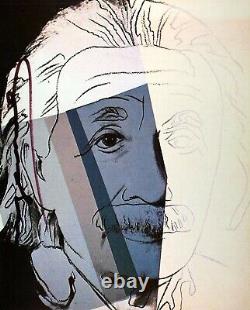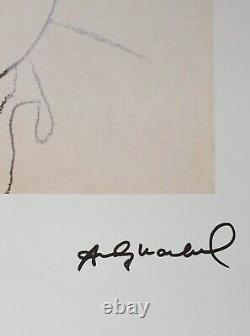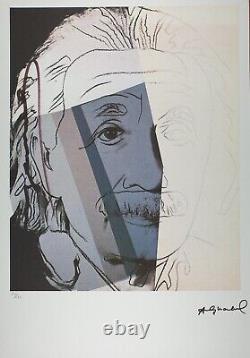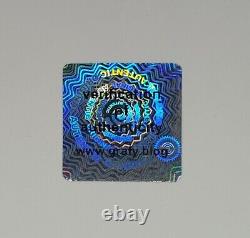
- Home
- Brand
- Department
- Format
- 4k Uhd Blu-ray (4)
- Bath Book (4)
- Book, Hardcover (9)
- Books (6)
- Bust (4)
- Cards, Flash Cards (3)
- Compact Disc (10)
- Dvd (28)
- Hardback (6)
- Hardcover (205)
- Library Binding (3)
- Mass Market (3)
- Mixed Lot (5)
- Paperback (17)
- Physical (9)
- Record (34)
- Single Issue (5)
- Trade Paperback (65)
- Unknown (20)
- Vinyl (3)
- Other (1830)
- Franchise
- Language
- Size Type
Andy Warhol, Albert Einstein Ten Portraits of Jews, Plate Signed Lithograph










Albert Einstein from Ten Portraits of Jews of the Twentieth Century. 13.77" x 19.69". 31.8 x 39.4. 12.51" x 15.51".
It sells as a copy -'As is. No certificate of authenticity (COA). You will receive the item from the photos. I accept return within 14 days.
The lithograph will be without a frame. Is a printing process that uses a flat stone or metal plate on which the image areas are worked using a greasy substance so that the ink will adhere to them by, while the non-image areas are made ink-repellent. A printing process based on the fact that grease and water do not mix.The image is applied to a grained surface (traditionally stone but now usually aluminium) using a greasy medium: such as a special greasy ink - called tusche, crayon, pencils, lacquer, or synthetic materials. Photochemical or transfer processes can also be used. A solution of gum arabic and nitric acid is then applied over the surface, producing water-receptive non-printing areas and grease-receptive image areas. The printing surface is kept wet so that a roller charged with oil-based ink can be rolled over the surface, and ink will only stick to the grease-receptive image area. Paper is then placed against the surface, and the plate is run through a press.
Lithography was invented in the late eighteenth century, initially using Bavarian limestone as the printing surface. Its invention made it possible to print a much wider range of marks and areas of tone than possible with earlier printmaking relief intaglio methods.
It also made colour printing easier: areas of different colours can be applied to separate stones and overprinted onto the same sheet. Offset lithography involves printing the image onto an intermediate surface before the final sheet. The process is'offset' because the plate does not come in direct contact with the paper, which preserves the quality of the plate. With offset lithography, the image is reversed twice and appears on the final sheet the same way round as on the stone or plate. ETCHING is a printmaking technique that uses chemical action to produce incised lines in a metal printing plate which then hold the applied ink and form the image.The plate, traditionally copper but now usually zinc, is prepared with an acid-resistant ground. Lines are drawn through the ground, exposing the metal. The plate is then immersed in acid, and the exposed metal is'bitten', producing incised lines.
Stronger acid and longer exposure produce more deeply bitten lines. The resist is removed, and ink applied to the sunken lines but wiped from the surface. The plate is then placed against the paper and passed through a printing press with great pressure to transfer the ink from the recessed lines.
Sometimes ink may be left on the plate surface to provide a background tone. Etching was used for decorating metal from the fourteenth century but was probably not used for printmaking much before the early sixteenth century. Since then many etching techniques have been developed, which are often used in conjunction with each other: soft-ground etching uses a non-drying resist or ground, to produce softer lines; spit bite involves painting or splashing acid onto the plate; open bite in which areas of the plate are exposed to acid with no resistance; photo-etching (also called photogravure or heliogravure) is produced by coating the printing plate with a light-sensitive acid-resist ground and then exposing this to light to reproduce a photographic image. Foul biting results from accidental or unintentional erosion of the acid resist.Like engraving, etching is an intaglio technique. Intaglio refers to all printing and printmaking techniques that involve making indents or incisions into a plate or print surface which hold the ink when ink is applied to the surface and then wiped clean. Andy Warhol was a leading figure in the Pop Art movement. Like his contemporaries Roy Lichtenstein and Robert Rauschenberg, Warhol responded to the mass-media culture of the 1960s.
His silkscreens of cultural and consumer icons-including Marilyn Monroe, Elizabeth Taylor, Campbell's Soup Cans, and Brillo Boxes-would make him one of the most famous artists of his generation. "The best thing about a picture is that it never changes, even when the people in it do, " he once explained. Born Andrew Warhola on August 6, 1928, in Pittsburgh, PA, he graduated from the Carnegie Institute of Technology in 1949.
Moving to New York to pursue a career in commercial illustration, the young artist worked for a magazine such as Vogue and Glamour. Though Warhol was a gay man, he kept much of his private life a secret, occasionally referencing his sexuality through art.
This is perhaps most evident in his drawings of male nudes from the 1950s, and later in his film Sleep (1963), which portrays the poet John Giorno nude. In 1964, Warhol rented a studio loft on East 47th street in Midtown Manhattan which was later known as The Factory.
The artist used The Factory as a hub for movie stars, models, and artists, who became fodder for his prints and films. The space also functioned as a performance venue for The Velvet Underground. During the 1980s, Warhol collaborated with several younger artists, including Jean-Michel Basquiat, Francesco Clemente, and Keith Haring.
The artist died tragically following complications from routine gallbladder surgery at the age of 58, on February 22, 1987, in New York, NY. After his death, the artist's estate became The Andy Warhol Foundation and in 1994, a museum dedicated to the artist and his oeuvre opened in his native Pittsburgh. Today, his works are held in the collections of the Art Institute of Chicago, the Whitney Museum of American Art in New York, and the Tate Gallery in London, among others. This item is in the category "Art\Art Prints". The seller is "floreacip" and is located in this country: RO.
This item can be shipped worldwide.
- Size: Medium
- Artist: Andy Warhol
- Production Technique: Offset Lithography
- Framing: Unframed
- Style: Pop Art
- Item Height: 19.69 in
- Material: Paper
- Theme: Art
- Type: Print
- Features: Signed, Numbered
- Image Orientation: Portrait
- Subject: Famous Paintings/Painters
- Certificate of Authenticity (COA): No
- Item Length: 13.77 in
- Signed: Yes
- Unit of Sale: Single Piece
- Listed By:: Dealer or Reseller
- Originality:: Reproduction
- Colour: Multi-Colour

